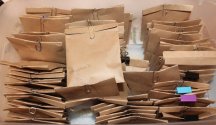COLLECTING & STORING POLLEN
View attachment 1715
Now that our male has begun dropping pollen, we can start our collection. I like to use a piece of glass (taken from a dollar store picture frame) and a coffee stirrer to free and collect the pollen.
⚠
Make sure to kill any large air movers that may disturb this process. The only air circulators you may want going is an extraction fan that can create the negative pressure to keep any stray pollen inside of a tent.
View attachment 1716
You will position your glass under the flower that is ready to drop, and just slightly agitate it with the stirrer. A slight small nudge is all that you need to free the pollen (pic 10,11).
Then, you will slowly use a razor blade to transfer the pollen from your collection surface into a storage container (pic 12). I use narrow necked glass vials.
⚠
Remember: we only need to collect 3-4 male flowers worth of pollen to have several single branch pollinations.
If you have no intention of collecting pollen for future work, then this single pollen collection is all you need to dust some branches (pic 13). So at this point, the male’s job is done and we can dispose of him long before he starts to really open up and create a high risk for accidental pollination.
View attachment 1717
You can use any smooth surface to collect the pollen. When there are hard to reach male flowers, I switch to a plant tag for collection (pic 14,15), so just be creative with what you have.
⚠
When you trash the male, be sure to change your clothes and shower before going near the flowering females. While there won’t be much pollen this early, it’s better to be safe than sorry.
View attachment 1718
Sometimes, I like to let the male flower out for long periods for larger stores of pollen and to make sure he doesn’t hermie later in flower. You can see the risk factor for accidental pollination escalates quickly at the male’s later stages, as he dumps tons of pollen. Ideally, your male will be long gone before this can happen (unless you want it to happen )
With your collected pollen (pic 13), you have 2 choices:
- If you’re doing just a few branch pollinations, the staggered timing of triggering the male, means your females are ready to be dusted and there is no need to worry about storing the pollen. You could move on to the section (Pollinating a Single Branch).
- If you would like to store the pollen, allow the container to dry overnight in a safe place away from fans. This allows any residual moisture to be purged for long-term storage.
⚠
Water is the enemy of pollen. Try not to get any plant material in your container as it can sweat moisture into your pollen and render it unviable. You can use this to your advantage, keeping a spray bottle with water on hand can allow you to spray around his tote if you fear any pollen may have escaped.
View attachment 1719
The next day, you can cap your container and place it in a labeled bag with a small desiccant for long term storage. Make sure to include the date the pollen was collected so that viability can be tracked. I like to prepare single-use vials that have just enough pollen so that when I take out and use it, there is nothing left. I don’t have to worry about freezing and defrosting the same container.
⚠
I try to use up pollen within a year of its collection. As the viability begins to drop off, you’ll notice fewer pollinated flowers as you continue to use the pollen. You’ll want to refresh your pollen bank as you notice the reduction in viability.
View attachment 1720
You can keep your packaged pollen containers in the freezer until you are ready for pollination. I keep a drawer in the freezer full of various pollens. Whenever I have female plants that are ready for dusting, I can make several crosses without having to constantly juggle multiple flowering males.






